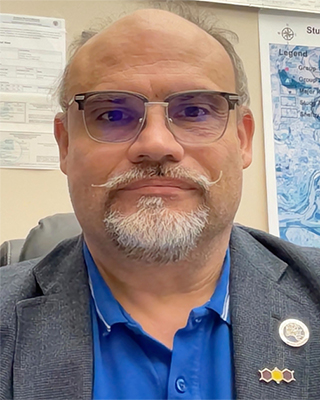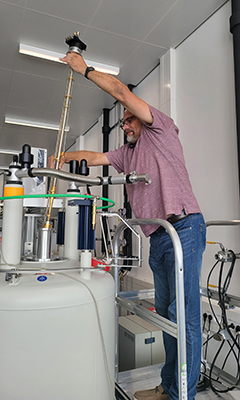May 2, 2024

Slawomir Lomnicki, Ph.D., is an environmental science professor at Louisiana State University. (Photo courtesy of Slawo Lomnicki)
Growing up in Toruń, Poland, Slawomir “Slawo” Lomnicki, Ph.D., enjoyed exploring nature beyond the city. Inspired by childhood outdoor activities — hiking, camping, and fishing with his father — Lomnicki now devotes his research to improving air quality for everyone’s benefit.
“You can avoid drinking dirty water by filtering, and you can avoid eating contaminated food, but when the air is dirty, you can’t stop breathing. I don’t like to see people struggle and suffer from air pollution,” said Lomnicki.
A member of the Louisiana State University (LSU) Superfund Research Program (SRP) Center, Lomnicki spearheads a project focused on contaminants called environmentally persistent free radicals (EPFRs). These contaminants can be found in the air and soil around Superfund sites, especially where hazardous waste is disposed of through burning.
EPFRs form when byproducts from burning waste, especially hazardous waste, combine with particulate matter in the air. Exposure to EPFRs can cause heart and lung dysfunction and is associated with higher rates of asthma in children. When EPFRs react with each other, they can form other pollutants such as dioxins, which can damage the immune and reproductive systems, as well as cause developmental problems, hormone disruptions, and cancer.
Lomnicki and team are studying EPFR formation and composition, and how to destroy them or prevent them from forming.
“This is where the NIEHS funding and research approach align very well with my philosophy,” said Lomnicki. “It’s not only about discovering the pollution, but also about understanding what impact it has on humans and the environment, then finding solutions — how we can prevent it and how we can remediate the environment and improve people’s lives.”
Investigating EPFRs
After earning his Ph.D. in physical chemistry from Adam Mickiewicz University in Poznań, Poland, Lomnicki accepted a position first at the University of South Carolina and next at LSU as a senior postdoctoral fellow, later becoming a research professor.

Lomnicki tests the LSU SRP Center’s electron paramagnetic resonance (EPR) spectrometer, still under construction. The cutting-edge machine will allow Lomnicki and his lab to characterize EPFRs from air samples even more accurately. (Photo courtesy of Slawomir Lomnicki)
For 15 years, Lomnicki collaborated with established LSU researcher Barry Dellinger, Ph.D., to better understand combustion emissions. Their pioneering research enabled Dellinger to establish LSU’s SRP Center in 2009 to analyze the chemicals using sophisticated imaging techniques. Since Dellinger’s death in 2014, Lomnicki has remained committed to advancing their field.
When the duo began their work, scientists knew that combustion produced highly reactive particles but did not know their composition.
Together, Lomnicki and Dellinger developed an influential theory of EPFRs, including what they are, how they form, and, in collaboration with biomedical researchers, how they affect human health.
“Our research indicated that, under certain conditions, tiny particles of pollutants suspended in the air – called particulate matter, or PM –interact to produce a new type of pollutant,” Lomnicki explained. “Our work has provided new understanding of the dangers of particulate matter exposure.”
Dedication to the Community
In 2015, Lomnicki’s work drew attention from government and military researchers, who needed help addressing the fallout from explosions at a munitions plant near Shreveport, Louisiana. Old munitions and hazardous materials had languished in storage at the plant for years before the degrading material eventually became unstable and exploded spontaneously, spewing a cocktail of dangerous chemicals and particulate matter into the air and water near a residential neighborhood.
Not only did the neighborhood need remediation, but the remainder of the munitions had to be disposed of quickly, before any more could explode.
“We helped the research partnership find ways to reutilize and dispose of the munitions materials,” Lomnicki explained.
The LSU SRP Center team helped select the design of a contained-burn chamber — a large, pressurized steel container designed to securely burn waste. The chamber pushes smoke from burning materials into a series of scrubbers and filters, which are designed to remove chemicals and particulate matter and monitor the air flowing out, ensuring contaminants are removed.
The LSU SRP Center remained engaged in the munitions disposal effort until completion.
Lomnicki, along with community engagement core colleagues, also engaged with the adjacent community, reporting back their findings and ensuring the residents had a way to voice concerns and ask questions during the cleanup.
Communities Wielding Knowledge
More recently, Lomnicki and colleagues have been working on urgent air pollution research in Colfax, Louisiana. A thermal treatment plant that accepted military waste from across the nation was disposing of hazardous chemicals through open burning, sending smoke into nearby Colfax. Members of the community were suffering from thyroid, respiratory, and skin problems. They suspected these ailments were linked to air quality and reached out to the LSU SRP Center.
The team jumped in to help by analyzing air quality. After identifying heavy metals like lead and copper, toxic compounds like dioxins and perchlorates, and EPFRs, they taught residents how to protect themselves. They recommended limiting outdoor activities during burn times, cleaning clothing exposed to particulates, consuming more antioxidant-rich foods, and limiting consumption of food from gardens or game hunting.
Bolstered by LSU SRP Center data, the community successfully petitioned the Louisiana Department of Environmental Quality to institute a strict closed-burn regulation, shuttering the plants’ open-burning operations. After an appeal from the plant’s management, the regulation is currently under review in federal court.
Meanwhile, the LSU SRP Center continues to sample air and provide residents with information they can share with healthcare providers to better understand how environmental factors may influence existing health conditions or cause new ones. Lomnicki’s lab is also developing air monitoring kits that residents can use to record data about their own immediate environment.
“I find it important to not only discover the mechanisms and health effects of pollution, but also find ways to help communities that cannot help themselves easily,” Lomnicki said.
Professional and Personal Passion
Lomnicki’s determination to protect people from air pollution carries into his personal life. His passion project is serving as a scientific advisor to the Louisiana Environmental Action Network (LEAN), a nonprofit that works to resolve Louisiana’s unique environmental issues.
LEAN received a grant from the U.S. Environmental Protection Agency to collect data about air pollution from industrial plants along the Mississippi River. Between December 2023 and March 2024, LEAN mounted samplers on cars that drove up and down the Mississippi River’s industrial corridor, between Baton Rouge and New Orleans, to collect detailed data on the concentration of major air pollutants.
Lomnicki’s role is to analyze the collected data and identify pollution hot spots. The growing body of data will be a decision-making resource for communities and environmental stewards alike.
“Since I have always been an outdoors person, I cherish the environment and care about its quality,” Lomnicki said. “And I’m very family-oriented, so I don’t like to see families struggle with the effects of pollution. That drives me to find what we can do to prevent people from getting sick.”


